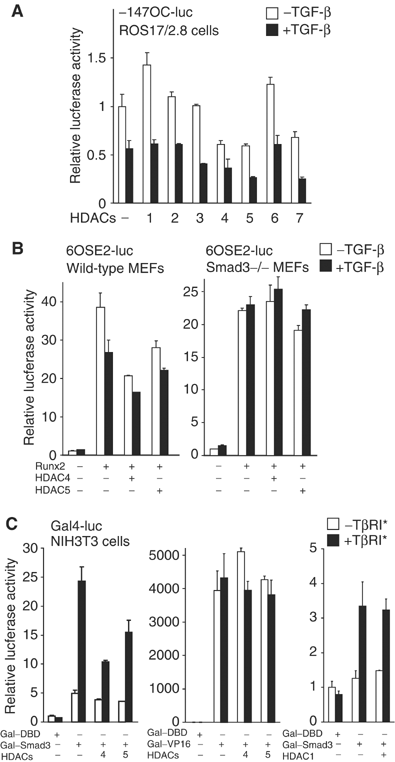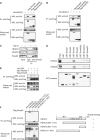Repression of Runx2 function by TGF-beta through recruitment of class II histone deacetylases by Smad3
- PMID: 15990875
- PMCID: PMC1176457
- DOI: 10.1038/sj.emboj.7600729
Repression of Runx2 function by TGF-beta through recruitment of class II histone deacetylases by Smad3
Abstract
Transforming growth factor-beta (TGF-beta) inhibits osteoblast differentiation through inhibition of the function of Runx2 (Cbfa1) by Smad3. The mechanism through which TGF-beta/Smad3 inhibits Runx2 function has not been characterized. We show that TGF-beta induces histone deacetylation, primarily of histone H4, at the osteocalcin promoter, which is repressed by TGF-beta, and that histone deacetylation is required for repression of Runx2 by TGF-beta. This repression occurs through the action of the class IIa histone deacetylases (HDAC)4 and 5, which are recruited through interaction with Smad3 to the Smad3/Runx2 complex at the Runx2-binding DNA sequence. Accordingly, HDAC4 or 5 is required for efficient TGF-beta-mediated inhibition of Runx2 function and is involved in osteoblast differentiation. Our results indicate that class IIa HDACs act as corepressors for TGF-beta/Smad3-mediated transcriptional repression of Runx2 function in differentiating osteoblasts and are cell-intrinsic regulators of osteoblast differentiation.
Figures








References
-
- Alliston TN, Derynck R (2000) Transforming growth factor-β in skeletal development and maintenance. In Skeletal Growth Factors, Canalis E (ed), pp 233–249. Philadelphia: Lippincott Williams & Wilkins Press
-
- Beck GR Jr, Sullivan EC, Moran E, Zerler B (1998) Relationship mineralization in differentiating MC3T3-E1 osteoblasts. J Cell Biochem 68: 269–280 - PubMed
-
- Berger SL (2002) Histone modifications in transcriptional regulation. Curr Opin Genet Dev 12: 142–148 - PubMed
Publication types
MeSH terms
Substances
Grants and funding
LinkOut - more resources
Full Text Sources
Other Literature Sources
Molecular Biology Databases

